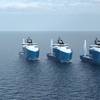Yonhap reported that South Korean shipyards have unparalleled competitiveness despite recent challenges posed by Chinese shipyards, industry and government sources said.
The optimistic predictions come as alarm bells have been sounded over Chinese yards outpacing domestic companies in shipbuilding orders received in the first two months of this year.
Such developments have caused some in China to boast that it can become the world's number one shipbuilding country by 2015.
The Korea Shipbuilders' Association (KOSHIPA) said China is competitive in relatively small-sized bulk carriers that are simple, low-tech and do not bring very big profits.
These views were echoed by Park Dong-hyuk, executive vice president for production management at Daewoo Shipbuilding and Marine Engineering Co. (DSME).
The executive of one of the top three shipyards in the world said there are still huge gaps between South Korean and Chinese yards in terms of technology levels, reliability and adherence to delivery schedules.
He said DSME and other South Korean yards such as Hyundai Heavy Industries Co. and Samsung Heavy Industries had enormous an talent pool for the designing of ships.
"While Japan opted to standardize its ships to cut costs in the 1990s, we strived to meet all sorts of customer demands," he said, adding that Daewoo had roughly 2,000 ship designers on its payroll. Park also said local yards had unparalleled access to about 1,500 companies that make all sorts of components for ships, and successfully achieved an economy of scale by using gigantic facilities.
DSME's number one dock is the largest in the world, measuring 541 meters long and 131 meters wide. It can be used to make up to seven very large bulk carriers, tankers, container ships and specialized platforms at the same time.
Park said all these efforts paid off in terms of a high local self-sufficiency rate for parts and revolutionary improvements in efficiency.
"The only royalty payments made by our yard are those that go to a French company that holds patents to make insulation for liquefied natural gas carriers," he said, adding that local research and development of a domestically-produced replacement is almost complete.
Others in the industry said DSME, Hyundai and Samsung had order backlogs of 3-4 years. They said after decades of experience, no other nation has the knowhow to churn out huge ships like large LNG carriers within 18 months or make high-tech ships like floating production storage and offloading (FPSO) vessels in less than 3 years. FPSO ships cost more than US$1 billion, while the price of LNG ships is $200-300 million.
Notwithstanding the upbeat mood, some sources said China is making steady inroads into the crude oil, LNG and container vessel sectors.
China is the second-largest builder of oil tankers with 36.2 percent of the global market and the fourth country in the world, after South Korea, Japan and Denmark, to build 8,000 TEU size container ships. TEU refers to standard 20-foot equivalent unit containers used to measure cargo ships.
Local shipyards are also redoubling their efforts to concentrate on floating maritime platforms that are gaining importance as countries seek resources in deep oceans.
Source: Yonhap News
Featured videos

Tracking Foreign Vessels Working in the U.S. Jones Act Market

Inmarsat Enhances Service to Drive Digitalization

Inside the Electrified Truckable Tug
Subscribe for
Maritime Reporter E-News
Maritime Reporter E-News is the maritime industry's largest circulation and most authoritative ENews Service, delivered to your Email five times per week









